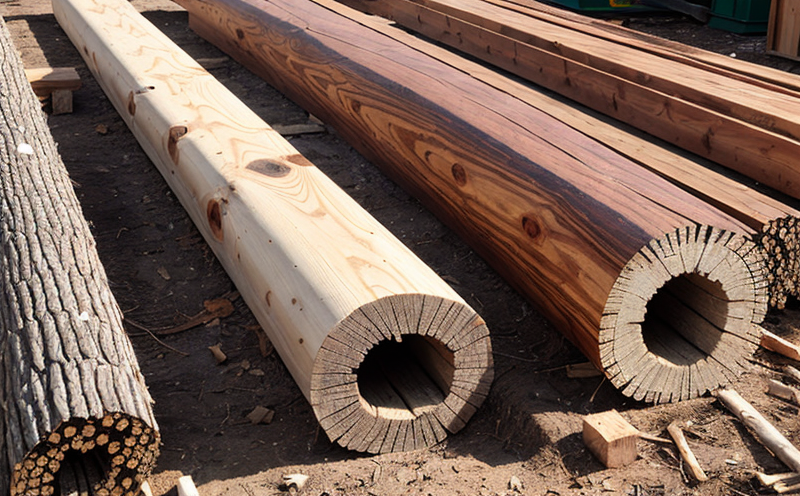Treated Wood Modulus of Rupture Testing
The Modulus of Rupture (MOR) or flexural strength is a critical property in assessing the durability and performance of wood that has been treated with preservatives. This test evaluates how well-protected the wood is against decay, insects, and other environmental stressors. In sectors such as agriculture and forestry, where structural integrity is paramount for longevity and sustainability, this testing is particularly important. The aim is to ensure that treated wood can withstand both mechanical stresses and environmental factors over its service life.
The process involves subjecting a specimen of the treated wood to controlled bending until failure occurs. This test provides insight into the material's ability to resist sudden, sharp loading conditions without breaking. For quality managers and compliance officers in agriculture and forestry, understanding this property is essential for selecting suitable treatments that enhance wood performance under real-world conditions.
From a research and development (R&D) perspective, MOR testing helps engineers design more resilient structures using treated wood. It allows them to optimize the amount of preservative needed based on expected environmental exposure. Procurement specialists can use this test data to select suppliers who consistently meet quality standards for treated wood products.
The Modulus of Rupture is measured in units like MPa or psi (megapascals or pounds per square inch). A higher value indicates greater resistance to bending stress, which translates into better durability. In the context of treated wood used in agricultural structures and forestry applications, ensuring adequate MOR can prevent premature failure due to weathering or pest damage.
Standardized methods for conducting this test include those specified by ASTM D143-20a, which provides a clear protocol for testing wood specimens using four-point flexure. The specimen is placed between two parallel supports with a third point applying a load until failure occurs. This approach ensures consistency and comparability across different laboratories.
For agricultural structures like fences or shelter belts, the MOR test results can inform decisions about maintenance schedules and replacement intervals. In forestry applications involving treated wood products such as poles or crossarms, knowing the MOR helps predict service life under various environmental conditions. By understanding these parameters, stakeholders in agriculture and forestry sectors can make informed choices that balance cost-effectiveness with long-term durability.
Scope and Methodology
The scope of our treated wood Modulus of Rupture testing includes compliance assessments for various preservative treatments. Our methodology adheres to international standards such as ASTM D143-20a, ensuring accurate and reliable results.
| Parameter | Description |
|---|---|
| Specimen Type | Square or rectangular cross-sections, typically 10x10 mm (ASTM D143-20a) |
| Test Setup | Four-point flexure on a universal testing machine |
| Load Application | Incremental until failure, recorded at maximum load |
| Environmental Conditions | Standardized to mimic real-world conditions (temperature and humidity)
The testing process begins with careful preparation of the wood specimens according to ASTM D143-20a specifications. This includes precise cutting, conditioning, and drying if necessary. Once prepared, the samples are subjected to controlled bending until failure under a known load.
Our laboratory uses state-of-the-art equipment calibrated per ASTM standards, ensuring consistent accuracy across all tests. The testing environment is maintained at specific temperature and humidity levels to simulate realistic conditions encountered by treated wood in agricultural and forestry settings.
Benefits
- Enhanced Durability: Ensures that treated wood can withstand mechanical stresses and environmental factors over its service life.
- Informed Decision-Making: Provides data for selecting appropriate preservative treatments based on expected exposure conditions.
- Improved Product Quality: Allows manufacturers to optimize treatment processes, leading to higher quality products.
- Compliance Assurance: Helps companies meet regulatory requirements and industry standards related to treated wood products.
- Sustainability: By extending the lifespan of treated wood, it reduces waste and promotes more sustainable practices in agriculture and forestry.
- Cost Efficiency: Through better understanding of material performance, organizations can avoid unnecessary expenditures on over-treatment or premature replacement.
- Data-Driven Insights: Offers valuable information for research and development purposes, aiding in the creation of more durable products.
Environmental and Sustainability Contributions
Incorporating treated wood into agricultural and forestry applications not only enhances structural integrity but also contributes positively to environmental sustainability. By ensuring that treated wood can withstand harsh conditions, we promote the use of renewable resources while minimizing waste. This approach supports sustainable practices by extending the useful life of materials used in these sectors.
Through our rigorous testing methods, we contribute to reducing the need for frequent replacements and repairs, thereby lowering overall environmental impact. The accurate assessment provided by Modulus of Rupture testing ensures that only necessary treatments are applied, preventing overuse of chemicals which could harm ecosystems.
The results from these tests help inform best practices in both production and application of treated wood products within agriculture and forestry industries worldwide. This contributes to global efforts towards sustainable development goals related to resource efficiency and reduction of waste generation.





